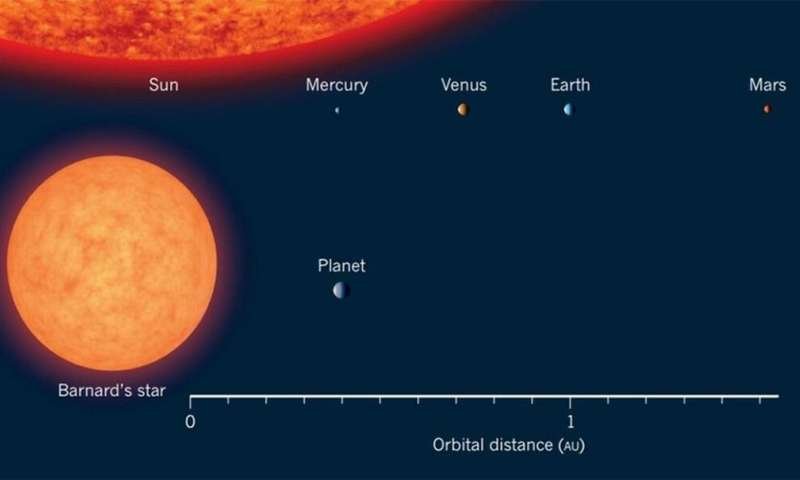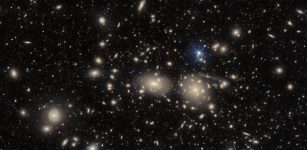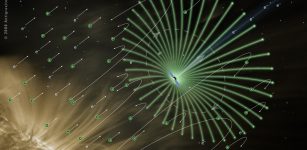Icy Barnard b Super-Earth Planet May Harbor Primitive Life If Geothermal Activity Exists
MessageToEagle.com – Barnard b (or GJ 699 b) is a recently discovered Super-Earth planet orbiting Barnard’s Star, making it the second nearest star system to the Earth.
Although likely cold (-170 degrees centigrade), it could still have the potential to harbor primitive life if it has a large, hot iron/nickel core and enhanced geothermal activity.
“Geothermal heating could support “life zones” under its surface, akin to subsurface lakes found in Antarctica,” Villanova University Astrophysicists Edward Guinan, said in a press release.

“We note that the surface temperature on Jupiter’s icy moon Europa is similar to Barnard b but, because of tidal heating, Europa probably has liquid oceans under its icy surface.”
Spotted using data from a global array of telescopes, the dimly lit world is the second-closest known exoplanet to Earth.
Barnard’s Star b, with a mass just over three times that of the Earth, orbits Barnard’s Star, a red dwarf star, every 233 days and at roughly the same distance that Mercury orbits the Sun. It passes near the dim star’s snow line.
Guinan and Engle have obtained high-precision photometry of Barnard’s Star (as well as dozens of other stars) for the past 15 years. Although very faint, it may be possible for Barnard b to be imaged by future very large telescopes, according to Guinan.
“Such observations will shed light on the nature of the planet’s atmosphere, surface, and potential habitability,” he added.
“Barnard’s Star has been on our radar for a long time,” Guinan said. “In 2003 it became a founding star member of the Villanova ‘Living with a Red Dwarf’ program that has been sponsored by the National Science Foundation/National Aeronautical and Space Administration (NASA).
“The most significant aspect of the discovery of Barnard’s star b is that the two nearest star systems to the Sun are now known to host planets. This supports previous studies based on Kepler Mission data, inferring that planets can be very common throughout the galaxy, even numbering in the tens of billions,” Ignasi Ribas, Director of the Institute of Space Studies of Catalonia (IEEC), and Institute of Space Sciences (ICE, CSIC), noted.
“Also, Barnard’s Star is about twice as old as the Sun – about 9 billion years old compared to 4.6 billion years for the Sun. The universe has been producing Earth-size planets far longer than we, or even the Sun itself, have existed.”
MessageToEagle.com
Related Posts
-
 Martian Paleolakes Are Breached And Drained By Outlet Canyons
No Comments | Nov 19, 2018
Martian Paleolakes Are Breached And Drained By Outlet Canyons
No Comments | Nov 19, 2018 -
 Cosmic Mystery: Universe Is Expanding Faster Than Can Be Explained By Our Current Understanding Of Physics
No Comments | Jan 20, 2025
Cosmic Mystery: Universe Is Expanding Faster Than Can Be Explained By Our Current Understanding Of Physics
No Comments | Jan 20, 2025 -
 Comets And Asteroids Likely Enhanced Life-Supporting Habitat On Red Planet
No Comments | Apr 6, 2016
Comets And Asteroids Likely Enhanced Life-Supporting Habitat On Red Planet
No Comments | Apr 6, 2016 -
 ‘Electric Sails’ Could Propel Superfast Spacecraft by 2025
No Comments | Nov 19, 2015
‘Electric Sails’ Could Propel Superfast Spacecraft by 2025
No Comments | Nov 19, 2015 -
 Heavy Metals On Earth Originate From Supernova Explosion
No Comments | Jun 18, 2019
Heavy Metals On Earth Originate From Supernova Explosion
No Comments | Jun 18, 2019 -
 Most Extreme Light Flashes In The Universe – Researchers Explore
No Comments | Oct 18, 2021
Most Extreme Light Flashes In The Universe – Researchers Explore
No Comments | Oct 18, 2021 -
 Amazing Astronomical Discoveries From Ancient Greece That Were Ahead Of Their Time
No Comments | May 25, 2020
Amazing Astronomical Discoveries From Ancient Greece That Were Ahead Of Their Time
No Comments | May 25, 2020 -
 Milky Way’s Giant Black Hole Probed Like Never Before
No Comments | Dec 6, 2015
Milky Way’s Giant Black Hole Probed Like Never Before
No Comments | Dec 6, 2015 -
 World’s Only Twin Asteroid Strike 60 Million Years Ago – Confirmed
No Comments | Oct 1, 2015
World’s Only Twin Asteroid Strike 60 Million Years Ago – Confirmed
No Comments | Oct 1, 2015 -
 Water-Worlds Are Scattered Throughout The Milky Way
No Comments | Aug 18, 2018
Water-Worlds Are Scattered Throughout The Milky Way
No Comments | Aug 18, 2018
